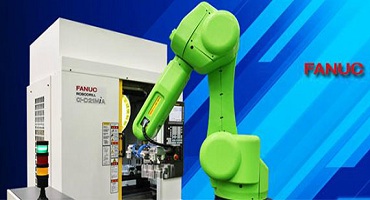A four-axis, twin-turret lathe can produce twice the amount of chips while turning than a single-turret lathe. That’s because tools on the upper and lower turrets cut simultaneously, with one turret slightly lagging the other as they both travel down the workpiece. The lagging turret’s tool engages the freshly cut diameter that the lead turret’s tool leaves behind.
Most of these twin-turret lathes have a slanted machine bed. However, William Gore points out that this design can allow the large volume of hot chips and hot coolant to collect in the lower turret area. Mr. Gore, a regional sales manager for Fuji Machine America (Vernon Hills, Illinois), says this can adversely affect the accuracy and longevity of such lathes.
Mr. Gore explains that the lathe bed can experience thermal growth as a result of the hot media, diminishing the machine’s turning precision. The situation can also accelerate the failure of the slide wipers and cause telescoping way covers to bind and leak. This exposes the ballscrew and guideways to hot metal chips, which can lead to more frequent maintenance or even damage to vital motion components.
Fuji’s ANS series of four-axis, twin-turret lathes has a vertical bed design that allows chips and coolant to fall straight down into the machine’s chip conveyor. That way, the hot material doesn’t collect on critical components, which enables the machine to maintain accuracy over a longer period of time, Mr. Gore says. The ANS machine line, which has an integral, two-axis gantry robot for automated loading, was introduced to the U.S. market at IMTS 2008.
This four-axis, twin-turret lathe has a vertical bed design. The 90-degree bed allows hot chips and coolant to fall directly into the chip conveyor without collecting on the lower turret area, which could lead to maintenance and precision issues.
An integral, two-axis gantry robot enables automated loading/unloading of shafts for this twin-turret lathe. The lathe’s vertical bed design provides the dual-arm robot with ample access to shafts.
Four-axis, twin-turret lathes are commonly used for long runs because setup takes longer than single-turret lathes. But because the ANS machines have a programmable follower rest and tailstock, it is possible to turn a family of shafts that have different lengths without requiring numerous setups, Mr. Gore says. An operator can simply call up a new part program and the machine will automatically adjust the follower rest and tailstock to the correct length for that job. (The follower rest is generally required for shafts with a length-to-diameter ratio greater than 10-to-1.) A shop can then efficiently run a mix of parts each day rather than large batches of a single shaft size. This reduces work in process and allows assemblies to be completed quicker because all necessary shaft sizes can be delivered to assembly sooner.
The ANS-300TT model offers X- and Z-axis travels of 4.33 and 18.90 inches, respectively, while the ANS-320TT offers 3.35 and 28.94 inches of X and Z travel. Both machines have a spindle diameter of 3.94 inches.





